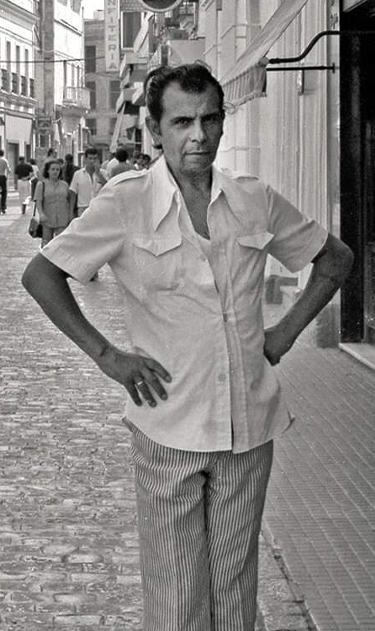Juan Núñez Gálvez, also called ‘El Cojo Farina’, was born in El Puerto de Santa María in the 1920s and died in Chiclana de la Frontera, the city he had made his own, in 1997. It is said that Farina’s nickname comes from the film series, Our Gang, screened in Spain between 1922 and 1931. In it, child actor Allen Clayton Hoskins (August 9, 1920-July 26, 1980) played a character called Farina, who was particularly mischievous.
A flamenco dancer and survivor, he was officially registered with the name Luis, but his mother, Gabriel Gálvez, always wanted him to be called Juan, and it was his father, Alonso Núñez ‘Orejitas’, who had registered him with the wrong saint’s name. For most of his life and until his death, he lived in Chiclana, although he danced his ‘pataíta‘ all the way from the Venta de Vargas, in San Fernando, to the main tablaos of Madrid.
“You walk with a limp, but you dance healthy”, observed José María Pemán when he saw him dancing. José de Mier described him thus: “Besides being a good person, he was pure sentiment, very intelligent and a friend of great poets and writers. He wrote poetry and spiced up any situation with his spontaneous grace.”
Beyond his artistic side, he fulfilled another essentially human one, that of advisor to those who wanted to be advised: “Juan Farina had something– that was indisputable. That gypsy was special. In spite of his physical problem, Juan handled flamenco dance with knowledge and good rhythm. He was everyone’s spiritual director, and his advice, his skillful words, shed great beams of light on the problems of his friends. And this wasn’t because he had none himself — as he said himself, every morning, hunger woke him before the sun, and it was his duty to feed his very large brood”, added Lolo Picardo.
“Leaving while staying” was how his friend Fernando Quiñones defined the moment of his departure because of the enormous mark he left in the memory of his loved ones. Alejandro Luque wrote the biography “Que me quiten lo bailao”. The Life and Art of Juan Farina, in which he describes the literary dimension of the artist, the person and the character, saying: “Farina didn’t need to write, because he was living literature. A character in several novels, but especially in two: El coro a dos voces by Quiñones, and Marea escorada by Berenguer, recently reissued. Félix Grande, Carmiña Martín Gaite and Manolo Ríos Ruiz spoke of him with admiration. He even danced for Cocteau.”
Praised equally by Chano Lobato, Tio Chele, El Chato de la Isla, José Menese and Sara Baras, he was one of the first to identify Camarón de la Isla’s talent. One of his most popular numbers was El picador.
And there are an immense number of anecdotes about him. Luque tells us that when Pemán recommended a surgeon to fix his hip, he made the sign of the horns and replied: “What if I then forget the dance?”
